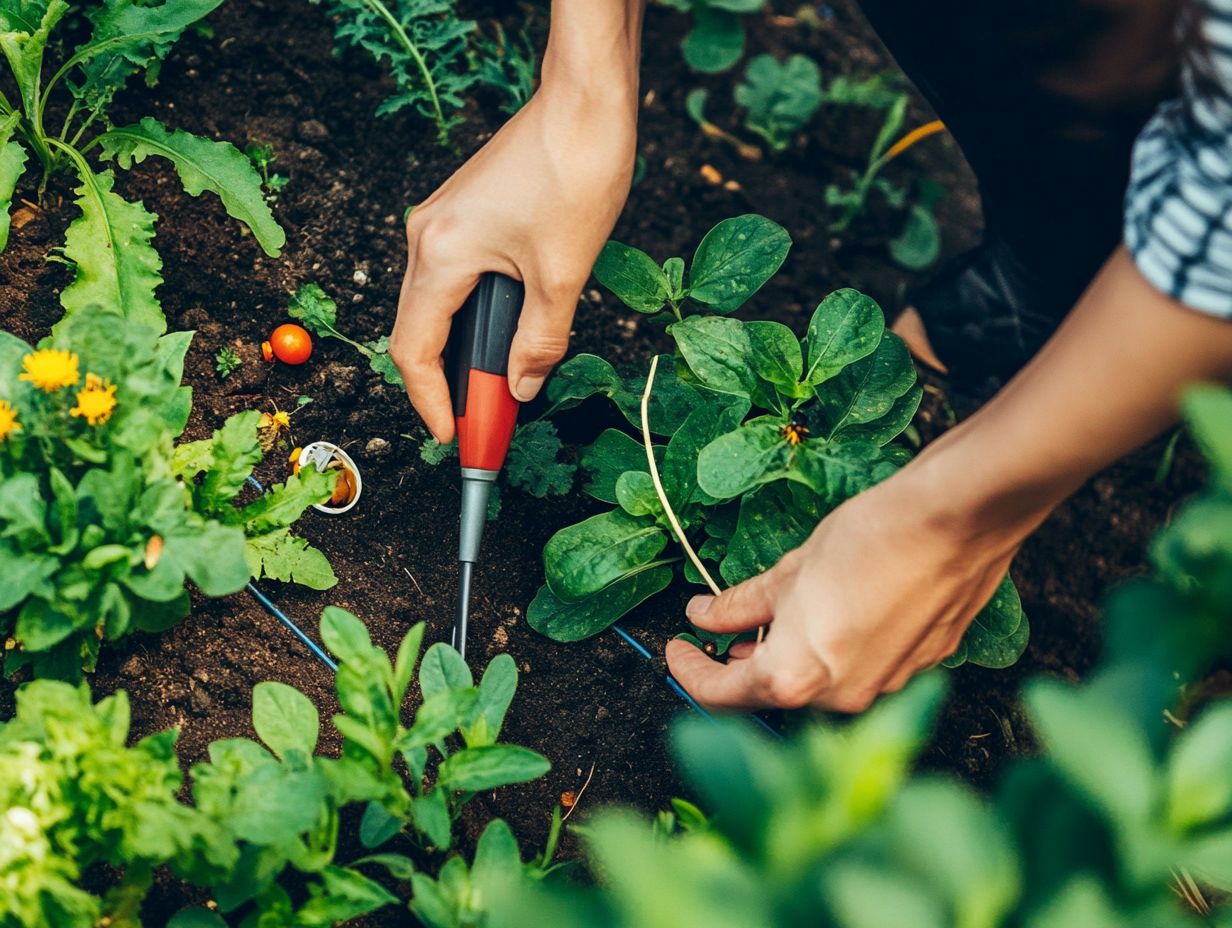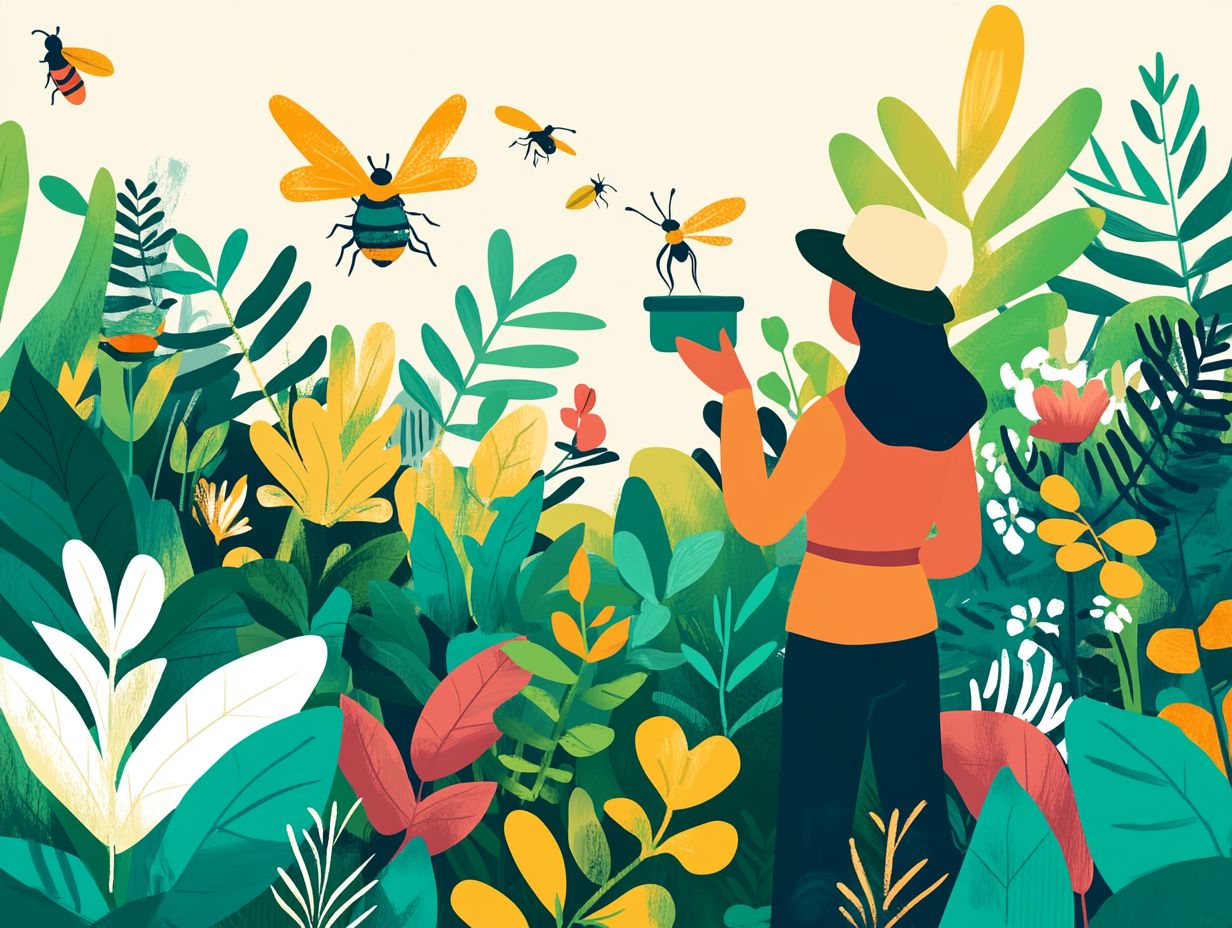Understanding Integrated Pest Management (IPM)
Integrated Pest Management (IPM) effectively manages pests while protecting our environment. This approach is key to sustainable pest management.
This article highlights the core principles of IPM in agriculture and organic food production. You ll discover practical prevention techniques and innovative control methods tailored for farms and urban areas.
We will discuss the challenges IPM faces and its future in sustainable pest management. Discover how IPM safeguards ecosystems and strengthens our food supply!
Contents
- Here are the Key Takeaways!
- What is Integrated Pest Management (IPM)?
- The Importance of IPM
- Key Components of IPM
- Implementing IPM in Different Settings
- Challenges and Criticisms of IPM
- Future of IPM
- Advancements and Potential Impact
- Frequently Asked Questions
- What is Integrated Pest Management (IPM)?
- What are the benefits of using IPM?
- What are the key principles of IPM?
- How does IPM differ from traditional pest control methods?
- Who can benefit from using IPM?
- What are some examples of IPM techniques?
Here are the Key Takeaways!

- IPM combines strategies like prevention, monitoring, and control methods.
- It benefits agriculture and the environment by reducing pesticide use and promoting sustainability.
- IPM adapts to various settings, ensuring effective pest monitoring.
What is Integrated Pest Management (IPM)?
Integrated Pest Management (IPM) is an environmentally sensitive approach to pest control. It combines multiple strategies to reduce the economic impact of harmful pests in agriculture.
IPM focuses on accurate pest identification and monitoring. Setting limits helps decide when to take action, ensuring effective pest management while considering environmental and health risks.
Definition and Principles
IPM principles rely on understanding pest biology and ecology. This knowledge helps implement practices that reduce reliance on chemical pesticides and promote non-chemical methods.
Using a holistic approach, you can mix various tactics tailored to your specific situation. This includes biological pesticides from natural organisms and mechanical methods that physically remove pests.
Non-chemical techniques like habitat manipulation can create conditions less favorable for pests. These strategies enhance your overall pest management efforts while protecting beneficial organisms and the ecosystem.
The Importance of IPM
IPM delivers significant economic benefits for agriculture while lowering environmental risks. This approach is foundational in sustainable pest management practices.
It stands as a vital strategy within pest management communities and aligns with the Federal Integrated Pest Management framework.
Benefits for Agriculture and the Environment
Adopting Integrated Pest Management (IPM) practices offers numerous benefits for both your agricultural endeavors and the environment. You can look forward to enhanced crop yields and the promotion of beneficial insects and organisms that support a thriving ecosystem.
By merging ecological principles with pest management, you can significantly reduce your reliance on chemical pesticides, leading to a robust IPM program implementation. This not only cuts operational costs but also helps mitigate potential health risks linked to chemical exposure. This approach elevates the quality of your crops and fosters enhanced biodiversity, allowing natural predators to flourish and reinforcing pest risk management.
Economic evaluations of these strategies indicate that implementing IPM over the long term can lead to greater profitability and improved pest management results. By sustaining soil health and reducing pest resistance, you equip your agricultural practices with a more resilient system to face future challenges.
Key Components of IPM

The key components of Integrated Pest Management (IPM) include pest prevention, monitoring, and the strategic application of suitable pest control methods.
Focusing on these elements allows you to manage pest populations effectively while promoting sustainable agricultural practices and effective pest control options.
Prevention and Monitoring
Prevention and monitoring can empower you to control pest outbreaks effectively, keeping pest populations below action thresholds and reducing reliance on pesticides through comprehensive pest management evaluations.
By adopting comprehensive pest prevention strategies, you can cultivate a balanced ecosystem that proactively deters pest infestations before they start. This often includes cultural practices like crop rotation, selecting resistant plant varieties, and encouraging natural predators, all working in harmony to alleviate pest pressures.
Consistent monitoring techniques such as regular field inspections and the strategic use of traps provide invaluable insights into pest activity. This crucial data enables you to make informed decisions, fine-tuning your management practices based on real-time observations of pest species.
Together, these strategies enhance your pest control efforts and promote sustainable agricultural practices that protect both your crops and the environment.
Control and Management Techniques
In Integrated Pest Management (IPM), you have a suite of control and management techniques at your disposal, including mechanical control, cultural methods, and the careful application of pesticides. These strategies minimize pest populations while decreasing reliance on chemical solutions.
For example, mechanical control methods use pest barriers and traps to significantly reduce pest survival rates. Cultural techniques embrace practices like crop rotation and smart irrigation management, creating environments that are less appealing to pests.
The use of biological pesticides, leveraging natural predators and pathogens, proves effective in maintaining ecological balance within pest management. By selecting pest-resistant varieties, you enhance the resilience of your crops, combining prevention, monitoring, and control into a seamless framework for effective pest management.
Implementing IPM in Different Settings
Implementing Integrated Pest Management (IPM) effectively demands a tailored approach across various settings whether in agricultural, residential, or commercial environments. This process requires seamless collaboration within the pest management community to ensure success.
Start implementing IPM today to safeguard your crops and the environment!
IPM in Agriculture
In agriculture, a smart way to control pests (IPM) is essential for achieving sustainable crop production and managing pest populations effectively.
By using methods like crop rotation and constant monitoring of pest species, you can create a thriving agricultural environment through diligent evaluations.
Integrating biological control methods meaning using natural predators to reduce pest numbers along with cultural practices and the selective use of pesticides when absolutely necessary, helps manage pests while minimizing your environmental footprint.
Crop rotation disrupts the life cycles of pests and enhances soil health, making it a cornerstone of effective IPM strategies.
Regular evaluations let you make smart decisions based on current pest pressures, enhancing both efficiency and resilience in your operations. This holistic approach supports healthier ecosystems and maximizes agricultural productivity and profitability. It also addresses ongoing challenges posed by pests and diseases, making it crucial for organic food production.
IPM in Residential and Commercial Settings

The implementation of IPM in both residential and commercial settings emphasizes safe pest management practices that prioritize human health, especially for children, along with environmental well-being.
This approach blends various strategies tailored to the specific needs of each location, tackling pest infestations through monitoring, exclusion, habitat modification, and judicious pesticide use but only when necessary. For example, effective rodent control often involves sealing entry points and maintaining a clean environment to deter nesting, which is crucial in homes.
Managing insect populations can include using natural predators. By focusing on non-toxic solutions and minimizing chemical treatments, IPM champions safety, making your home or business a safer place!
This commitment ensures that both people and pets are protected while reducing adverse effects on beneficial organisms and the surrounding ecosystem.
Challenges and Criticisms of IPM
Despite its advantages, IPM faces challenges and criticisms, including economic concerns. You may hear fears about its practical limitations and the potential economic implications from pest management practices, including health risks associated with pesticide exposure.
Limitations and Controversies
The controversies surrounding IPM often arise from differing interpretations and debates over the effectiveness of pesticide application within its framework.
These discussions highlight the tension between maximizing crop yield and minimizing environmental and health risks, such as pesticide exposure. Critics may point out that some advocates of IPM tend to overlook ecological considerations for immediate agricultural gains, raising valid concerns about long-term sustainability.
As you evaluate management practices, you might notice inconsistencies in implementing IPM strategies across regions, leading to questions about their overall effectiveness. Stakeholders including farmers, regulators, and environmental advocates often struggle to balance economic needs with ecological integrity.
Engaging in thorough discussions is essential for refining IPM approaches and fostering a more sustainable agricultural future.
Future of IPM
The future of IPM is set to experience remarkable advancements, fueled by continuous research and an increasing appreciation for its critical role in effective pest risk management and enhancing beneficial organisms.
Adopt IPM strategies today for better pest management and a healthier environment!
Advancements and Potential Impact
Advancements in Integrated Pest Management (IPM) are poised to provide you with new pest control options. This shift is a big step towards sustainable farming. Researchers are exploring innovative solutions like pheromone traps and tiny worms that target and kill pests. By cultivating partnerships between universities, agricultural organizations, and local farmers, the IPM community aims to devise tailored strategies that address the unique pest challenges of your region.
Such collaborations promote knowledge sharing and enhance the implementation of environmentally friendly techniques. These include natural pest control and organic food production, ultimately resulting in healthier ecosystems and more resilient crops for you to enjoy!
Frequently Asked Questions

What is Integrated Pest Management (IPM)?
Integrated Pest Management (IPM) is an approach used to manage and control pest populations sustainably and environmentally. It involves a combination of techniques, including cultural, biological, and chemical methods, to prevent and manage pests effectively.
What are the benefits of using IPM?
IPM helps reduce the use of harmful pesticides. It promotes biodiversity, minimizes the risk of pesticide resistance, and addresses the economic threat posed by pest populations. IPM also saves costs and provides long-term solutions for managing pests.
What are the key principles of IPM?
The key principles of IPM include identifying the pest problem through careful pest identification, monitoring pest populations using effective techniques, implementing preventative measures, and continuously evaluating the effectiveness of chosen strategies.
How does IPM differ from traditional pest control methods?
Traditional pest control often relies on chemical pesticides to eradicate pests. In contrast, IPM focuses on long-term prevention and management using various techniques. It also considers the potential impact of pest control methods on the environment and non-target species.
Who can benefit from using IPM?
IPM is beneficial for farmers, gardeners, and homeowners who want to control pests sustainably. It is also applied in commercial and industrial settings, such as schools, hospitals, and office buildings.
What are some examples of IPM techniques?
Examples of IPM techniques include crop rotation, use of resistant plant varieties, biological control, physical barriers, and proper sanitation practices. These methods help prevent and manage pests without relying on harmful pesticides.






